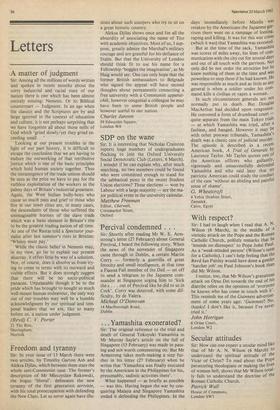... Yamashita exonerated?
Sir: The original reference to the trial and death of General Tokoyuki Yamashita in Mr Murray Sayle's article on the fall of Singapore (13 February) was made in pass- ing and not worth commenting on. But Mr Armstrong takes myth-making a step fur- ther in his letter (27 February) when he writes that 'Yamashita was finally executed by the Americans in the Philippines for his, presumably, sadistic activities there'.
What happened — as briefly as possible — was this. Having begun the war by con- quering Malaya and Singapore Yamashita ended it defending the Philippines. In the
days immediately before Manila was retaken by the Americans the Japanese gar- rison there went on a rampage of looting, raping and killing. It was for this war crime (which it was) that Yamashita was executed. But at the time of the sack, Yamashita was scores of miles away, his lines of com- munication with the city cut for several days and out of all touch with the garrison. Not only did he not order the atrocities but he knew nothing of them at the time and was powerless to stop them if he had known. He was responsible as much and as little as any general is when a soldier under his com- mand kills a civilian or rapes a woman. In such circumstances generals are not normally put to death. But Douglas MacArthur had decided upon vengeance. He convened a form of drumhead court quite separate from the main Tokyo trials — at which Yamashita was tried, after a fashion, and hanged. However it may be with other postwar tribunals, Yamashita's death was a classic case of judicial murder. The episode is described in a recent American book, A Trial of Generals by Laurence Taylor. Mr Taylor quotes one of the American officers who gallantly, vigorously and unsuccessfully defended Yamashita and who said later that no patriotic American could study the conduct of the case 'without an abiding and painful sense of shame'.
G. Wheat croft
4 Yehia Ibrahim Street, Zamalek, Cairo, Egypt


































 Previous page
Previous page